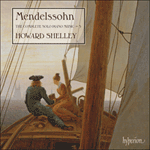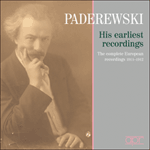
Welcome to Hyperion Records, a British classical label devoted to presenting high-quality recordings of music of all styles and from all periods from the twelfth century to the twenty-first.
Hyperion offers both CDs, and downloads in a number of formats. The site is also available in several languages.
Please use the dropdown buttons to set your preferred options, or use the checkbox to accept the defaults.

| Howard Shelley (piano)» More |
Mendelssohn was characteristically reticent to fit titles to his Lieder ohne Worte, preferring instead to present them just as they were, as autonomous musical statements far more ‘specific’ than the ambiguities of words. Nevertheless, he did publish Op 53 No 5 as a Volkslied—that is to say, it is a piano piece that emulates the qualities and character of folk music, in particular of the Scottish variety. After a brisk introductory flourish, which recurs interlude-like twice more and then again in the coda, we hear the simulated folk tune, presented in chordal style, with a melody not unlike the opening of Mendelssohn’s ‘Scottish’ Symphony, inspired by his visit to Edinburgh in 1829 but finished only in 1843. What is more, Mendelssohn’s newly composed folk melody seems to have inspired Brahms at mid-century. One of the episodes in the finale of his Piano Sonata in C major, Op 1, seems suspiciously derived from it—not only is it in the same key of A minor, but Brahms’s inspiration, according to Albert Dietrich, was Robert Burns’s poem ‘My heart’s in the Highlands’.
Two other Lieder in Op 53 originally had titles that Mendelssohn suppressed upon their publication. No 3 in G minor bears the title Gondellied (Gondola song) in its original autograph, but it is difficult to imagine that Mendelssohn was thinking here of something analogous to his three celebrated Venetianische Gondellieder included in three other volumes of his Lieder ohne Worte. Their gentle barcarolle rhythms and dappled sonorities yield in Op 53 No 3 to assertive, driving rhythms and agitated arpeggiations, though admittedly the accumulated energy of the piece is dispersed at the end in a drawn-out diminuendo and quiet ending. No 4 in F major was originally titled Abendlied (Evening song), certainly appropriate for this quiet, nocturne-like gem, even though Mendelssohn removed this identifying clue. One other piece in the set, the virtuosic No 6, was apparently a response to the piano music of Sigismond Thalberg, Liszt’s rival in the 1830s, who visited Leipzig in 1841 and impressed audiences with chromatic passages alternating rapidly between the hands. According to Charles Edward Horsley, Mendelssohn began experimenting with the device, and approximated it in No 6, with scintillating, piquant chromatic clashes, above which, nevertheless, a lyrical melody sings.
from notes by R Larry Todd © 2015
Comme à son habitude, Mendelssohn était réticent à donner des titres à ses Romances sans paroles, préférant les présenter telles qu’elles sont, comme des déclarations musicales autonomes beaucoup plus «explicites» que l’ambiguïté des mots. Néanmoins, il publia l’op.53 nº 5 comme un Volkslied—c’est-à-dire une pièce pour piano qui rivalise avec les qualités et le caractère de la musique traditionnelle, en particulier de la musique écossaise. Après un geste d’introduction vif, qui revient à deux reprises comme un interlude, puis à nouveau dans la coda, on entend l’air traditionnel simulé, présenté en accords, avec une mélodie qui ressemble un peu au début de la Symphonie «Écossaise» de Mendelssohn, dont il trouva l’inspiration lors de son voyage à Édimbourg en 1829, mais qu’il acheva seulement en 1843. Qui plus est, la mélodie traditionnelle composée par Mendelssohn semble avoir inspiré Brahms au milieu du siècle. L’un des épisodes du finale de sa Sonate pour piano en ut majeur, op.1, a tout l’air d’en être dérivé—il est non seulement dans la même tonalité de la mineur mais, selon Albert Dietrich, Brahms trouva son inspiration dans le poème «My heart’s in the Highlands» («Mon cœur est dans les Highlands») de Robert Burns.
Deux autres romances de l’op.53 avaient à l’origine des titres que Mendelssohn supprima lors de leur publication. La troisième en sol mineur porte le titre de Gondellied («chanson de gondolier») dans l’autographe original, mais il est difficile d’imaginer que Mendelssohn pensait ici à quelque chose de similaire à ses trois célèbres Venetianische Gondellieder («Chansons de gondolier vénitienne») qui figurent dans trois autres volumes de ses Romances sans paroles. Dans l’op.53 nº 3, leurs doux rythmes de barcarolle et leurs sonorités pommelées cèdent le pas aux rythmes assurés et pressants et aux arpèges agités, mais il est vrai que l’énergie accumulée du morceau se dissipe à la fin dans un diminuendo étiré et une conclusion calme. Le nº 4 en fa majeur s’intitulait à l’origine Abendlied («Chant du soir»), titre certainement approprié pour ce joyau calme dans le style d’un nocturne, même si Mendelssohn supprima cet indice. Un autre morceau de ce recueil, le virtuose nº 6, était apparemment une réaction à la musique pour piano de Sigismond Thalberg, le rival de Liszt dans les années 1830, qui se rendit à Leipzig en 1841 et impressionna les auditeurs avec une alternance rapide de passages chromatiques entre les mains. Selon Charles Edward Horsley, Mendelssohn commença à expérimenter ce procédé et s’en rapprocha dans le nº 6 avec des conflits chromatiques brillants et piquants, au-dessus desquels chante néanmoins une mélodie lyrique.
extrait des notes rédigées par R Larry Todd © 2015
Français: Marie-Stella Pâris
Mendelssohn zog es bekanntermaßen vor, seinen Liedern ohne Worte keine Titel zu geben, sondern sie stattdessen als autonome musikalische Aussagen—damit weitaus „spezifischer“ als die Mehrdeutigkeit von Worten—stehen zu lassen. Nichtsdestotrotz veröffentlichte er op. 53 Nr. 5 als Volkslied, was bedeutet, dass es sich dabei um ein Klavierstück handelt, welches die Eigenschaften und den Charakter von Volksmusik, genauer: schottischer Volksmusik, nachzeichnet. Nach einer lebhaften Einleitung, die zweimal als eine Art Zwischenspiel und dann noch einmal in der Coda wiederholt wird, erklingt die simulierte Volksweise als akkordischer Satz, wobei die Melodie an den Beginn von Mendelssohns „Schottischer“ Symphonie erinnert, die von seinem Edinburgh-Aufenthalt 1829 inspiriert war, jedoch erst 1843 fertiggestellt wurde. Zudem scheint auch Mendelssohns neukomponierte Volksmelodie Brahms gegen Mitte des Jahrhunderts inspiriert zu haben. Eine Episode im Finale seiner Klaviersonate C-Dur, op. 1, hat einen verdächtig ähnlichen Hintergrund—nicht nur steht sie in derselben Tonart, a-Moll, sondern Brahms’ Inspirationsquelle war Albert Dietrich zufolge das Gedicht „My heart’s in the Highlands“ von Robert Burns.
Zwei weitere Lieder von op. 53 waren ebenfalls ursprünglich mit Titeln versehen, die Mendelssohn bei der Veröffentlichung dann jedoch wegließ. Nr. 3 in g-Moll war im Autograph als Gondellied bezeichnet, doch scheint es kaum vorstellbar, dass Mendelssohn hier Ähnliches wie bei seinen drei berühmten Venetianischen Gondelliedern, die in drei anderen Heften seiner Lieder ohne Worte vorliegen, im Sinn hatte. Die sanften Barkarole-Rhythmen und hingetupften Klänge jener Stücke weichen in op. 53 Nr. 3 vorwärtstreibenden, entschlossenen Rhythmen und erregten Arpeggierungen, obwohl die angehäufte Energie des Werks sich zugegebenermaßen am Schluss in einem ausgedehnten Diminuendo auflöst und das Stück ruhig endet. Nr. 4 in F-Dur hieß ursprünglich Abendlied, was auf dieses leise, Nocturne-artige Juwel durchaus passt, selbst wenn Mendelssohn diesen Hinweis später entfernte. Ein weiteres Stück in dem Zyklus, die virtuose sechste Nummer, war offensichtlich eine Reaktion auf die Klaviermusik von Sigismond Thalberg, Liszts Rivale in den 1830er Jahren, der 1841 nach Leipzig reiste und das Publikum mit schnell zwischen den Händen hin- und herwechselnden chromatischen Passagen beeindruckte. Charles Edward Horsley zufolge begann Mendelssohn, mit diesem Stilmittel zu experimentieren; in Nr. 6 machte er in Form von brillanten, pikanten chromatischen Kollisionen offenbar davon Gebrauch, wobei darüber trotzdem eine lyrische, kantable Melodie erklingt.
aus dem Begleittext von R Larry Todd © 2015
Deutsch: Viola Scheffel
 Mendelssohn: The Complete Solo Piano Music, Vol. 3 Mendelssohn: The Complete Solo Piano Music, Vol. 3A welcome new addition to Howard Shelley’s definitive Mendelssohn piano music cycle.» More |
 Paderewski - His earliest recordings Paderewski - His earliest recordings |

